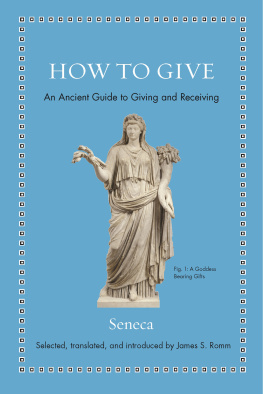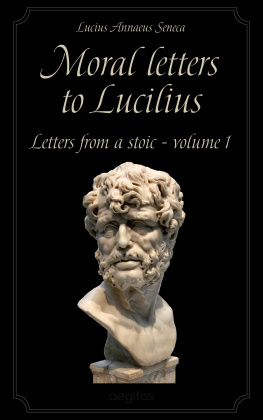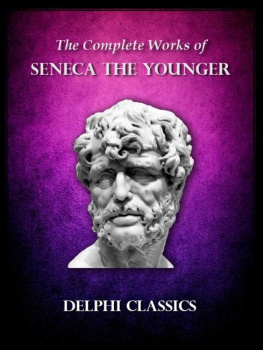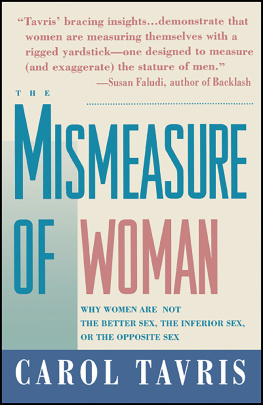Contents
Guide
Page List
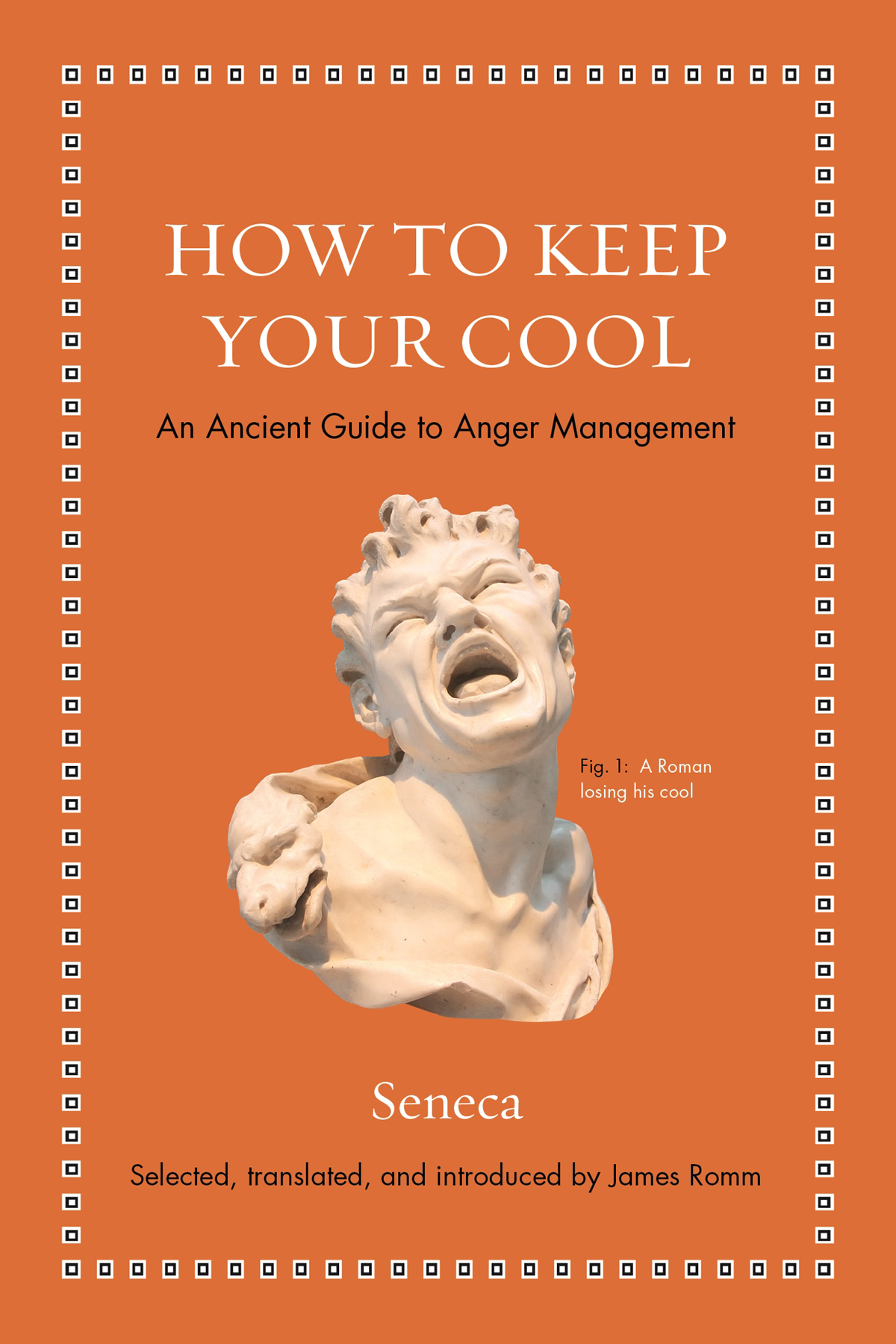
HOW TO KEEP YOUR COOL
ANCIENT WISDOM FOR MODERN READERS
How to Keep Your Cool: An Ancient Guide to
Anger Management by Seneca
How to Think about War: An Ancient Guide to
Foreign Policy by Thucydides
How to Be Free: An Ancient Guide to
the Stoic Life by Epictetus
How to Be a Friend: An Ancient Guide to
True Friendship by Cicero
How to Die: An Ancient Guide to
the End of Life by Seneca
How to Win an Argument: An Ancient Guide to
the Art of Persuasion by Cicero
How to Grow Old: Ancient Wisdom for
the Second Half of Life by Cicero
How to Run a Country: An Ancient Guide for
Modern Leaders by Cicero
How to Win an Election: An Ancient Guide for
Modern Politicians by Quintus Cicero
HOW TO KEEP
YOUR COOL
An Ancient Guide to Anger Management
Seneca
Selected, translated, and
introduced by James Romm
PRINCETON UNIVERSITY PRESS
PRINCETON AND OXFORD
Copyright 2019 by Princeton University Press
Published by Princeton University Press
41 William Street, Princeton, New Jersey 08540
6 Oxford Street, Woodstock, Oxfordshire OX20 1TR
press.princeton.edu
All Rights Reserved
Library of Congress Control Number: 2018953760
ISBN 9780691181950
eISBN 9780691186139 (ebook)
Version 1.0
British Library Cataloging-in-Publication Data is available
Editorial: Rob Tempio and Matt Rohal
Production Editorial: Mark Bellis
Jacket Credit: courtesy of Shutterstock
Production: Erin Suydam
Publicity: Jodi Price
Copyeditor: Molan Goldstein
CONTENTS
vii
INTRODUCTION
Your anger is a kind of madness, because you set a high price on worthless things. Seneca the Younger wrote those words in the mid-first century AD, as the Roman principate, the system of one-man rule inaugurated by Augustus Caesar, reached its fourth generation. Seneca ostensibly addressed that thought to his elder brother Novatus but really intended it for all his Roman readers, and it continues to speak powerfully today, in an age that still struggles, more than many previous ones, to deal with insanities wrought by anger.
To better grasp what Seneca means when he defines anger as a misvaluation, try the following exercise. Recall the last minor incident that sent you into a rage. Perhaps a reckless driver cut you off and made you slam on your brakes, or someone cut in line in front of you or stole a parking spot or a cab from under your nose. You were injuredor were you? Were you notably worse off, a day or two later, than before the incident occurred? Did it really matter that someone disrespected you, in the way that global climate change matters? Or the threat of nuclear war? Or the fact that stars are collapsing into black holes in other parts of our galaxy, swallowing up everything around them?
The juxtaposition of the quotidian with the immeasurably vast is a favorite stratagem of Senecas, especially in On Anger (De Ira in Latin), the essay from which this volume is drawn. By shifting our perspective or expanding our mental scale, Seneca challenges our sense of what, if anything, is worth our getting angry. Pride, dignity, self-importancethe sources of our outrage when we feel injuredend up seeming hollow when we zoom out and see our lives from a distance: Draw further back, and laugh (3.37). Senecas great exemplars of wisdomSocrates, the most revered sage in the Greek world, and Cato the Younger, a senator of the century preceding Senecas, in the Roman worldare, in this essay, seen getting spat on, knocked about, and struck on the head without expressing anger or even, it seems, feeling any.
An infringement on your cars right of way might not matter, but your reaction to it does, Seneca believed. In your momentary road rage, in your desire to honk at, hurt, or kill the other driver, lie grave threats to the sovereignty of reason in your soul, and therefore to your capacity for right choice and virtuous action. The onset of anger endangers your moral condition more than that of any other emotion, for anger is, in Senecas eyes, the most intense, destructive, and irresistible of the passions. Its like jumping off a cliff: once rage is allowed to get control, theres no hope of stopping the descent. Our spiritual health demands that we let go of anger, or else it will never let go of us.
Seneca knew at first hand the perils of anger. By the time he came to write On Anger, or at least the greater part of it, he had witnessed, from the close vantage point of the Roman Senate, the bloody four-year reign of Caligula. (We might give other names than anger to Caligulas maladiesparanoia, say, or sadismbut Seneca, to advance his case, lumps all of that emperors cruelties under the heading ira). Caligula casts a long shadow over On Anger; Seneca often mentions him by name, but also invokes him implicitly when he associates anger with instruments of torture, with flames and swords, and with civil strife. The nightmare of the Caligula years, it seems, had taught Seneca the high cost of unrestrained wrath, not just to the individual soul, but to the whole Roman state.
It was unusual in Rome for a philosopher and moral essayist to occupy a seat in the Senate, but Seneca was an unusual man. In youth he studied with teachers who embraced Stoicism, a system imported from Greece that counseled mental self-control and adherence to the dictates of divine Reason. He chose to follow the Stoic path, but not in any orthodox way; as a mature writer, he drew on many philosophic traditions, or else eschewed theory altogether in favor of practical ethics enhanced by rhetorical flourish. On Anger is a case in point: only a portion of the treatise, largely confined to the first half, is demonstrably rooted in Stoic principles. The second half, from which much of this volume is drawn, deals with the problem of anger more pragmatically, reminding us, in its most banal passages, not to overload our schedules, or take on tasks at which were likely to fail.
Seneca, to judge by his self-presentation in his writings, was a self-reflective and inward-looking man. He describes, in one of the passages translated below (3.36), his zen-like nightly reviews of his own ethical choicestranquil meditations conducted in the quiet of his bedroom. Yet we know that Seneca also enjoyed proximity to power and eagerly played the game of Roman politics, sometimes with disastrous results. In his thirties, he entered the Roman Senate, where he gained a reputation as an original and compelling speaker, but his eloquence only aroused the envy of emperor Caligula, who reportedly wanted him killed (but was himself assassinated before taking action). Under Claudius, Caligulas successor, Seneca came under suspicion again and was exiled to Corsica; the charge brought against him, adultery with one of Caligulas sisters, was likely a pretext. Quite possibly On Anger was begun during that period of exile.
After eight years on Corsica, and the near-extinction of his political career, Seneca was recalled to Rome in AD 49 with a most important brief: instructing and guiding the thirteen-year-old Nero, Claudiuss adopted son and presumptive heir. With the support of Agrippina, another of Caligulas sisters and Claudiuss new wife, Seneca became more influential than ever, and also extremely rich. It was at about this time, presumably, that he completed On Anger (our only firm clue as to its date is that Novatus, to whom it is addressed, changed his name to Gallio in late 52 or early 53, so the treatise must have been published before that). Perhaps the work was circulated at Rome to herald its authors return there, and to advertise the humanity of the man reentering the inner circle of imperial powermuch as a modern politician might publish a memoir prior to a run for higher office.





